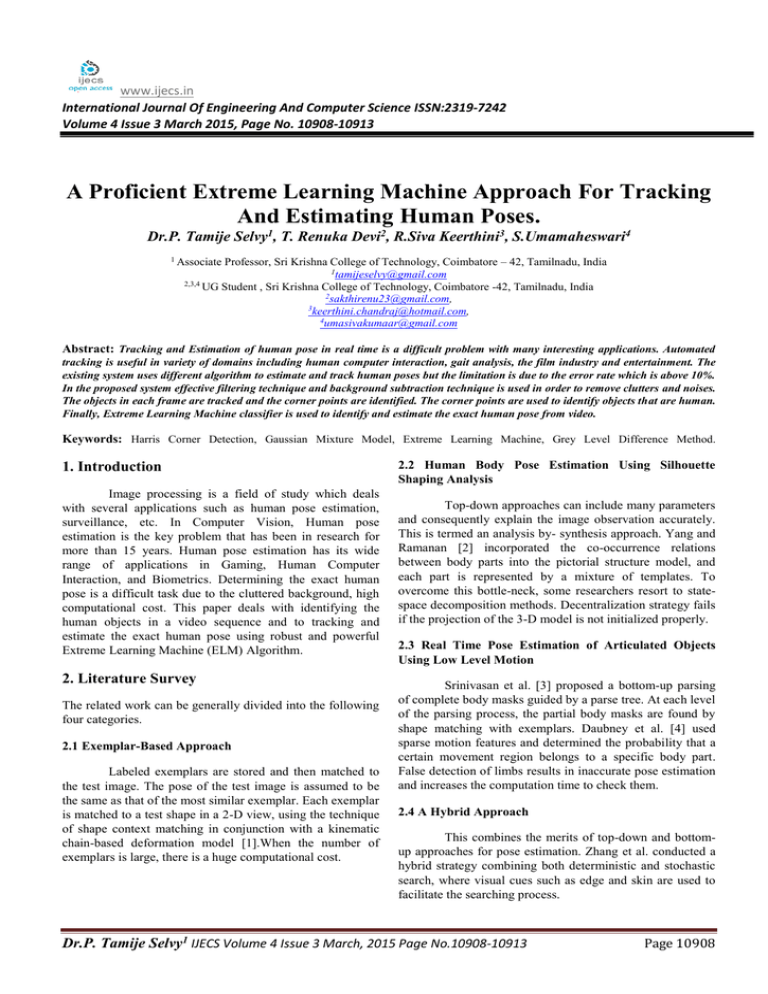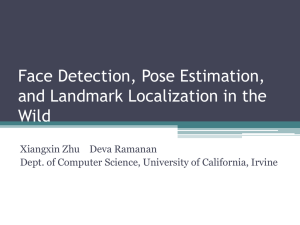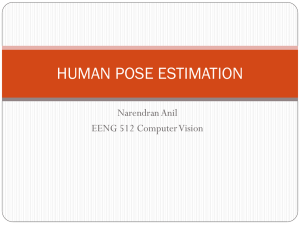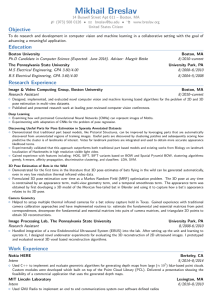www.ijecs.in International Journal Of Engineering And Computer Science ISSN:2319-7242
advertisement

www.ijecs.in
International Journal Of Engineering And Computer Science ISSN:2319-7242
Volume 4 Issue 3 March 2015, Page No. 10908-10913
A Proficient Extreme Learning Machine Approach For Tracking
And Estimating Human Poses.
Dr.P. Tamije Selvy1, T. Renuka Devi2, R.Siva Keerthini3, S.Umamaheswari4
Professor, Sri Krishna College of Technology, Coimbatore – 42, Tamilnadu, India
1tamijeselvy@gmail.com
2,3,4 UG Student , Sri Krishna College of Technology, Coimbatore -42, Tamilnadu, India
2sakthirenu23@gmail.com,
3keerthini.chandraj@hotmail.com,
4umasivakumaar@gmail.com
1 Associate
Abstract: Tracking and Estimation of human pose in real time is a difficult problem with many interesting applications. Automated
tracking is useful in variety of domains including human computer interaction, gait analysis, the film industry and entertainment. The
existing system uses different algorithm to estimate and track human poses but the limitation is due to the error rate which is above 10%.
In the proposed system effective filtering technique and background subtraction technique is used in order to remove clutters and noises.
The objects in each frame are tracked and the corner points are identified. The corner points are used to identify objects that are human.
Finally, Extreme Learning Machine classifier is used to identify and estimate the exact human pose from video.
Keywords: Harris Corner Detection, Gaussian Mixture Model, Extreme Learning Machine, Grey Level Difference Method.
1. Introduction
Image processing is a field of study which deals
with several applications such as human pose estimation,
surveillance, etc. In Computer Vision, Human pose
estimation is the key problem that has been in research for
more than 15 years. Human pose estimation has its wide
range of applications in Gaming, Human Computer
Interaction, and Biometrics. Determining the exact human
pose is a difficult task due to the cluttered background, high
computational cost. This paper deals with identifying the
human objects in a video sequence and to tracking and
estimate the exact human pose using robust and powerful
Extreme Learning Machine (ELM) Algorithm.
2. Literature Survey
The related work can be generally divided into the following
four categories.
2.1 Exemplar-Based Approach
Labeled exemplars are stored and then matched to
the test image. The pose of the test image is assumed to be
the same as that of the most similar exemplar. Each exemplar
is matched to a test shape in a 2-D view, using the technique
of shape context matching in conjunction with a kinematic
chain-based deformation model [1].When the number of
exemplars is large, there is a huge computational cost.
2.2 Human Body Pose Estimation Using Silhouette
Shaping Analysis
Top-down approaches can include many parameters
and consequently explain the image observation accurately.
This is termed an analysis by- synthesis approach. Yang and
Ramanan [2] incorporated the co-occurrence relations
between body parts into the pictorial structure model, and
each part is represented by a mixture of templates. To
overcome this bottle-neck, some researchers resort to statespace decomposition methods. Decentralization strategy fails
if the projection of the 3-D model is not initialized properly.
2.3 Real Time Pose Estimation of Articulated Objects
Using Low Level Motion
Srinivasan et al. [3] proposed a bottom-up parsing
of complete body masks guided by a parse tree. At each level
of the parsing process, the partial body masks are found by
shape matching with exemplars. Daubney et al. [4] used
sparse motion features and determined the probability that a
certain movement region belongs to a specific body part.
False detection of limbs results in inaccurate pose estimation
and increases the computation time to check them.
2.4 A Hybrid Approach
This combines the merits of top-down and bottomup approaches for pose estimation. Zhang et al. conducted a
hybrid strategy combining both deterministic and stochastic
search, where visual cues such as edge and skin are used to
facilitate the searching process.
Dr.P. Tamije Selvy1 IJECS Volume 4 Issue 3 March, 2015 Page No.10908-10913
Page 10908
Motivation
Tracking and estimating human poses ia
challenging task due to its cluttered background, poor
illumination or partial self-occlusion. The traditional systems
remove the clutters, poor illumination. But the performance
is not efficient enough when the background of the images
have many clutters also these systems can estimate the
human poses only from static images. To overcome these
short comings, a system is proposed which is much more
efficient in identifying and estimating the human poses.
Here background subtraction technique is used to remove the
clutters from the image and the ELM algorithm is used to
extract human object from the images and to estimate human
poses accurately. Section 3 describes the modules in the
proposed human pose estimation system. Section 4 details
about Performance Evaluation In terms of Execution time,
Specificity, Sensitivity, Accuracy. The last section concludes
the paper with the scope of future Enhancement.
Input Video
Convert Video to Frame
Gaussian Filter and Histogram Equalization
(Pre-Processing)
Gaussian Mixture Model (Background
Subtraction)
Markov Chain Monte Carlo Algorithm
(Pose Tracking)
Feature Extraction
(Gray Level Difference Method and Harris
Corner Detection Algorithm).
3. Proposed System
The goal of the proposed system is to provide the system
with greater accuracy in identifying the human poses. One of
the key issues in identification is when the images are with
cluttered background and poor-illumination. To overcome
this problem background subtraction method is used. The
images for the proposed system are taken from Weizzman
Dataset. The system has the following phases I.
Preprocessing using Histogram Equalization II. Background
Subtraction using Gaussian Mixture Model. III. Identifying
the objects from the frames using Monte Carlo and Harris
Corner Algorithm. IV. Identifying the human objects using
the features derived. V. Human Pose Estimation using
Extreme Learning Machine Algorithm. Figure 1 gives the
complete overview of the system.
Human Identification
(Threshold Comparison)
Not
Human
If (Human)
Yes
Pose Tracking and Estimation
(Extreme Learning Machine)
Figure 1: System Overview
3.1 Pre-Processing
Histogram Equalization is a method in image
processing for contrast adjustment and for enhancement of
images.The image is loaded into the dataset. Input image is
resized and the color image is first transformed into a gray
level image. Filtering technique such as mask filter and
weighted average filter are applied for removing noise.
Weighted average filter [R] is calculated using equation (1)
gives more weight to the center value.
1
R=[1
1
1
−8
1
1
1]
1
%% Filter mask
(1)
By using histogram equalization, the quality of the image is
enhanced. The output of this module is shown in Figure 2.
Dr.P. Tamije Selvy1 IJECS Volume 4 Issue 3 March, 2015 Page No.10908-10913
Page 10909
Figure 3. Background Subtraction
3.3 Object Tracking
Figure 2: Pre-processing
3. 2 Background Subtraction
Background subtraction or Foreground detection is
a technique in image processing where the unwanted
background is subtracted and the region of interest is
extracted. Background subtraction is a widely used technique
for detecting moving objects from a static frame. The
rationale in the approach is that of detecting the moving
objects from the difference between the current frame and a
reference frame, often called “background image”, or
background model”.
The first frame is stored as a background image. The current
frame with the pre stored background image is subtracted
and the difference is estimated. If the difference is greater
than the bound threshold, then it determines that the pixel to
pixel on the moving target, or as the background pixel.
Threshold value is estimated using the equation (2) and (3).
Rk(x, y) = fx(x, y) – B(x, y)
Dx(x,y) = {
1 𝑏𝑎𝑐𝑘𝑔𝑟𝑜𝑢𝑛𝑑 𝑅𝑘(𝑥, 𝑦) > 𝑇
0 𝑡𝑎𝑟𝑔𝑒𝑡 𝑅𝑘(𝑥, 𝑦) ≤ 𝑇
Markov chain is a class for sampling from a
probability distribution based on constructing a Markov
chain that has equilibrium distribution.
The human body is modeled as a three level tree
structure which consists of ten body parts: The root: torso,
The second level: head, left/right upper arm, The third level:
left/right lower arm, left/right lower leg. The pose of the
human body is X = {X1 , X2, · · ·,X10}, where Xi represents an
individual articulated part i. In detail, body part i is
represented by a rectangle, and parametrically characterized
as Xi = {xi, yi, θi, li,wi} where xi, yi and θi are position and
orientation relative to its parent, and li, wi are length and
width respectively. Object tracking is shown in Figure 4.
(2)
(3)
Where,
B(x,y) – Co-ordinates to represent background image.
fx(x,y) - Co-ordinates to represent the size of the first frame.
Dx(x,y) - Co-ordinates to represent the image based on the
threshold value
The output from background subtraction module is shown in
figure 3.
Figure 4: Object Tracking
3.4 Gray level difference method
In photography and computing, a gray scale digital
image is an image in which the value of each pixel is a single
sample that carries only intensity information. So, it is also
called as black-and-white image. Grey level difference
method is summarized as follows,
Dr.P. Tamije Selvy1 IJECS Volume 4 Issue 3 March, 2015 Page No.10908-10913
Page 10910
Step 1: For each pixel in image, get the different red, green
and blue values of the pixel.
Step 2: Implement math operation to turn those different
pixel values into single gray value as in equation (4).
Gray = (Red+ Green+ Blue) / 3;
(4)
Step 3: Replace RGB (red, green, blue) value with new gray
value.
3.5 Harris Corner Detection
In Computer Vision, corner detection is an approach
to extract certain kinds of features and infer the content of
the Image. The resultant image is shown in figure 5.
The steps involved in Harris corner detection are,
Figure 5: Feature Extraction
Step 1: Use gradient formulation as per equation (5) to detect
response at any shift (x, y).
3.6 Human Identification
E ( u,v)= ∑(𝑥,𝑦) 𝑤(𝑥, 𝑦)[𝐼(𝑥 + 𝑢, 𝑦 + 𝑣) − 𝐼(𝑥, 𝑦)]2 (5)
The tracked object can be any objects in the frame
(say, car, man, animal etc,). In order to determine human
follow the steps given below.
Where,
Input: Corner Points, Texture Points
W(x,y) – Window Function
Output: Human Identification
I(x + u,y + v) - Shifted Intensity
I (x,y) - Intensity Instead of 0-1 weight use
Gaussian function w( x , y ).
Step 2: Reformulation is calculated by using the equation (6)
M=∑(x,y)w(x,y)
[
Ix2
Ix Iy
Ix Iy
]
Iy2
(6)
Step1: Find the mean value of the corner points and texture
values in the frame.
Step 2: Compare mean with the threshold value.
Step 3: If the mean value is equal to threshold value, the
tracked object is human otherwise it is not human. Figure 6
displays the object whether it is human or not.
Step 3: Eigen values of M correspond to principle curvature
of the local autocorrelation function is calculated by using
the following equation (7).
R=det M −k (traceM )2
(7)
Where,
k – Empirical constant (k = 0.04-0.06).
Step 4:
if (R is large ) return corner,
if ( R is negative with large magnitude ) return edge,
Figure 6: Human Identification.
if (|R| is small ) return (flat region).
3.7 Pose Tracking and Estimation
The output from this module is shown in figure 5.
Extreme Learning Machine (ELM) is a supervised
learning for a class of feed forward neural networks with
random weights that has recently been used with success for
the classification of hyper spectral images. It has its
Dr.P. Tamije Selvy1 IJECS Volume 4 Issue 3 March, 2015 Page No.10908-10913
Page 10911
applications in character recognition, pose estimation, spam
filtering, search engine and computer vision.,
Using classification technique, different poses are
trained and tested using ELM algorithm [1].
Input: Corner points, texture values, foreground area values.
1
Proposed algorithm
55
45
2
Markov Chain Monte
50
60
6
120
Carlo algorithm
3
Exemplar Based
algorithm
Output: Human Pose Estimation.
The following are the steps involved in identifying the
human poses, and the resultant is shown in figure 7.
Step 1: Extract the human, corner points, texture points and
foreground values.
Step 3: For the subsequent frames,
•
•
•
Test for human candidate using the trained
human dataset.
Recursively obtain the human for each of
the frames.
Time (sec)
Step 2: Train the values to estimate the poses using the
dataset.
140
Proposed
algorithm
120
100
80
Markov
Chain
Monte Carlo
algorithm
60
40
20
0
Approaches
Determine pose of human in different
frames.
Exempler
Based
algorithm
Figure 8: Execution Time
The pose estimation result is shown in Figure 7.
4.2 Accuracy Estimation
The performance measure of the algorithm is
calculated by comparing the performance of SVM [5] and
ELM algorithm. It is evaluated based on the three validation
measures (i.e.) Sensitivity, Specificity and Accuracy. They
are based on True Positive (TP), False Positive (FP), True
negative (TN) and False Negative (FN). Sensitivity measures
the ability of the proposed method to identify the abnormal
cases. Sensitivity is calculated as per the formula (8).
Specificity measures the ability of the method to identify
normal cases; it is calculated from the following formula (9).
The accuracy of the system is identified using (10).The
performance of our system using ELM is compared with
SVM and the comparison table and comparison chart is
shown in the Table 2 and Figure 8 respectively.
Figure 7: Pose Tracking and Estimation
4. Performance Evaluation
Sensitivity =
𝑇𝑃
(𝑇𝑃+𝐹𝑁)
4.1 Execution Time
The duration of the project execution is evaluated
and compared with the existing systems as in Table. 1 and
Figure. 7 respectively.
Specificity =
Accuracy =
𝑇𝑁
(𝑇𝑁+𝐹𝑃 )
(𝑇𝑃+𝑇𝑁)
(𝑇𝑃+𝑇𝑁+𝐹𝑃+𝐹𝑁)
(8)
(9)
(10)
Table 1: Execution time Comparison
No. of
S.No
Methods
Iteration
Time
Table 2: Comparison Table for ELM and SVM
(seconds)
Dr.P. Tamije Selvy1 IJECS Volume 4 Issue 3 March, 2015 Page No.10908-10913
Page 10912
S.No
Method
Specificity
Sensitivity
Accuracy
(%)
(%)
(%)
1
SVM
97.98
94.17
92
2
ELM
98.45
94.77
92.8
[3] B. Daubney, D. Gibson, and N. Campbell, “Real-time
pose estimation of articulated objects using low-level
motion,” in Proc. Int. Conf. Comput. Vision Pattern
Recognit., 2008, pp. 1–8.
[4] P. Srinivasan and J. Shi, “Bottom-up recognition and
parsing of the human body,” in Proc. Int. Conf. Comput.
Vision Pattern Recognit., 2007, pp. 1–8.
[5] P.Tamije Selvy-(2012), An Improved GA-MILSVM
Classification approach for diagnosis of breast lesions from
stain images, International Journal of Advances in Engg&
Tech., Sep. 2012,ISSN:2231-1963
[6] C. Stauffer and W. Grimson, “Adaptive background
mixture models for real-time tracking,” in Proc. Int. Conf.
Comput. Vision Pattern Recognit., vol. 2, 1999, pp. 246–252.
100
Author Profile
Range
98
96
SVM
94
ELM
92
90
88
Specificity
Accuracy
Sensitivity
Figure 9: Comparison chart for ELM and SVM
5. Conclusion
The proposed system estimates the human pose
effectively compared to earlier systems. The efficiency of the
system is achieved through Gaussian filter and histogram
equalization. The corner points of the objects identified by
object tracking are used to identify the human. By using
Extreme Learning machine different poses are estimated
efficiently and effectively. The results from experiments
carried out shows that the implemented human pose
estimation using ELM approach is better than the earlier
systems in terms of sensitivity, specificity and prediction
accuracy. The system can be enhanced using optimization
techniques such as Particle swarm optimization (PSO) and
Ant Colony Optimization Technique (ACO).
Dr.P. Tamije Selvy received B .Tech (CSE),
M.Tech (CSE), and PhD (CSE) in 1996, 1998
and 2013respectively. She has been working as
faculty in reputed Engineering Colleges. At
present, she is working as Associate Professor in the
department of Computer Science and Engineering, Sri
Krishna College of Technology, Coimbatore. Her Research
interest includes Image Processing, Data Mining and Pattern
Recognition.
Ms. T. Renuka Devi is currently pursuing
Bachelor’s degree in Computer Science and
Engineering at Sri Krishna College of
Technology, Coimbatore. Her area of interest
includes Image Processing and Data Mining.
Ms .R. Siva Keerthini is currently pursuing
Bachelor’s degree in Computer Science and
Engineering at Sri Krishna College of
Technology, Coimbatore. Her area of interest
includes Image Processing and Data Mining
Ms. S. Umamaheswari is currently pursuing
Bachelor’s degree in Computer Science and
Engineering at Sri Krishna College of
Technology, Coimbatore. Her area of interest
includes Image Processing and Data Mining
References
[1] A. Faith and G. Mori, “Human pose estimation using
motion exemplars,”inProc. Int. Conf. Comput. Vision, 2007,
pp. 1–8.
[2] A. Mittal, L. Zhao, and L. Davis, “Human body pose
estimation using silhouette shape analysis,” in Proc. Int.
Conf. Adv. Video Signal Based Surveill. 2003, pp. 263–270.
Dr.P. Tamije Selvy1 IJECS Volume 4 Issue 3 March, 2015 Page No.10908-10913
Page 10913




